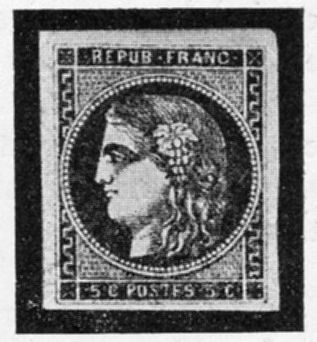 |
| Source |
The early postal arrangements of France were often disturbed by war and revolution. French stamps provide a very interesting record of the political changes in the country, and provide one of the best illustrations of how stamps demarcate the periods of a nation's history.
The election of Louis Napoleon to the presidency of the French Republic in December 1848 resulted in the temporary restoration of law and order.
The Story of the First French Stamps
The government of Louis Philippe had witnessed the establishment of the cheap postage system in England eight years before, but, notwithstanding the repeated demands of the mercantile community, had taken no steps towards its introduction in France. It was reserved to the Republic to confer the desired boon on the people, and accordingly in the autumn of 1848, under the régime of Etienne Arago, the decree was issued, fixing the uniform postal rates at 20 centimes and 1 franc, and ordaining the emission of stamps, of those values on the 1st January, 1849.
There remained between the issue of the decree and the date indicated for the appearance of stamps, an interval of only three months in which to prepare the supplies; and but for an accident, the work of engraving he dies and printing of the stock would have been confided to an English firm. Pressed for time, the government applied to Messrs. Bacon & Perkins (or sir Perkins, as the French called him) for an estimate. “Sir Perkins” replied that he would require six months to deliver the stamps, and that his price was one franc per sheet of 240. This being an exorbitant price, and the time demanded exceeded by law, the government broke off the negotiations, and looked about for a French engraver.
Not many months before, when coin was scarce, the French finance minister had requested the Bank o France to issue a large number of 200 franc notes – and the plate, that of the 200 franc notes, and the engraving of a new plate was reckoned to cost a thousand pounds and eighteen months to a couple of years labour In this difficulty recourse was had to an engraver named Hulot, who in two months completed the plate of the present 100 franc note, and turned out a sufficient supply. To him the government now addressed itself, and a week before 1st January, 1849, every post office in France was provided with stamps, besides which there remained in stock a surplus of ten millions.
The type, of which the printing was superintended by M. Hulot, was actually engraved by M. Barre, and remains to this day one of the finest productions , if not the finest, among stamp designs. Everything is in the best of taste, and the only fault found with the design is based on utilitarian grounds, the numeral of value is not sufficiently conspicuous.
Of the two first issued stamps, the 20 c. made its appearance in black, and the one franc in vermilion. The latter is counted among the choicest rarities in a collection, and it is not surprising that it should be so scarce, seeing that it only remained in circulation for twelve months. It was then withdrawn, because the post office was about to issue the 40 c. orange, and feared that the two values would be confounded together, on account of their similarity of colour, joined to their identity of design.
Probably in revision of the issue of 40 centime stamps, for which orders were given in April, the one franc, as early as August 1849, was printed in carmine. Finally, about the time of the emission of the 40 c. the one franc was issued in dark carmine.
The 40 c. orange made its appearance in December, 1849, or January, 1850, and the provincial offices received their supplies during the first ten days of February. This stamp is found in several shades of orange.
By the law of the 15-18th May, 1850, a retrograde step was made in the postal tariff, the weight for a single weight letter being thereby fixed at 25 centimes. This necessitated the issue of the 25 c. blue, which took place on the 1st July following, blue being chosen to replace the black of the 20c., because the latter colour was reserved for the postmarks. The change in the rate gave rise to another call on M. Hulot’s energies, and led incidentally to the printing off of a supply of a provisional stamp, which was never issued.
When after the passage of the law, M. Hulot was requested to prepare a new plate, he was unable to assure the Minister o Finance that it would be ready in time, and it was therefore agreed that he should print a supply of stamps in blue from the 20 c. dies, and surcharge them with the figures 25 c. in red. However, M. Hulot was able to get ready the plate of the new 25 c., and to print a sufficient supply from it within the given time; so the provisionals were all destroyed, save some very few specimens, of which only three or four are known to exist. Some of the 20 c. blue without the surcharge not mixed, it is supposed, with the supplies of the 25 centime blue, as an obliterated 20 c. blue is in the possession of a Parisian collector.
On the 12th (or the 23rd) July, 1850, the 15 c. green made its appearance, and on the 12th of the following September, the 10 c. brownish yellow, or cinnamon, completed the series. All the values, except the 1 franc vermilion, but including the embryo 20 c. blue, were reprinted in 1862. The reprints are distinguishable by the lightness and brightness of their tints. The obliterations are of three kinds: (1) a lozenge formed of seven crossed bars, – the well-known “grid-iron mark; (2) a six-pointed star of dots; and (3) a lozenge formed of dots, with the post office number in the centre. The two latter are also found on the imperial stamps.
The first French stamps are inscribed REPUB. FRANC., and followed in the wake of the revolution of 1848 when M. Etienne Arago was in charge of the post office. The head on the stamp engraved by the elder Barre is not the head of Liberty, as is commonly supposed, but that of Ceres, the Italian goddess of Agriculture, who was the same as the Greek Demeter or "Mother Earth," appropriate for the design of the stamps of a country which is "one of Ceres' chiefest barns for corn." The stamps were imperforated and colour varieties of each of the six values may be found.
But the calm of 1848 was of short duration. In December 1851, a coup d'etat was engineered by Napoleon and the legislative assembly dissolved. Chaos once more reigned for a while and, when it died down, two new stamps were provided in 1852.
The Coup D'Etat of 1851
 On the 2nd December, 1851, occurred the coup d’état, which gave to Prince Louis Napoleon the actual supremacy. The profile of Liberty on the stamp was no longer appropriate. The Republic existed I name, but the President was the de facto ruler. This state of things is accurately indicated on the presidential stamps.
On the 2nd December, 1851, occurred the coup d’état, which gave to Prince Louis Napoleon the actual supremacy. The profile of Liberty on the stamp was no longer appropriate. The Republic existed I name, but the President was the de facto ruler. This state of things is accurately indicated on the presidential stamps. The title, REPUB. FRANC., remains, but the portrait is that of Napoleon.
They were, moreover, in their essence, “provisional” stamps, destined to remain current for a brief time. The 25 c. blue was issued on the 12th August, 1852. The portrait of the Prince-President was executed with the same carefulness, and by the same hand, as the profile of Liberty. Beneath the neck appears a minute capital B – the initial of Barre, the engraver’s name. The blue 25 c., like the blue stamps for the Republic and the Empire, differs very much in the intensity of shade, varying from a light to a full dark blue.
The Empire
After the declaration of the Empire, it became time to think of changing the obsolete description on the stamp, REPUB. Was taken out and replaced by EMPIRE, and the metamorphosis was complete.
The issue of the imperial stamps commenced in August, 1853, with the 10 c. cinnamon; the value used for the Parisian rate. A few days after wards, the 1 franc carmine followed, a stamp, which is now getting of a certain rarity. Then came, on the8th November the 25 c. blue. This last had but a brief currency, for it was soon after decided to return to the old rate of 20 centimes, and it is consequently a trifle rarer than its companion low values.
The 20 centimes blue came out on the 1st July, 1854. A universally recognised very dark variety o this colour exists. In October, 1854, appeared the 80 centimes green, inaugurating the establishment of low rates for printed matter, was issued. From that time up to 1866, no further change was made.
Instead of the head of Ceres, we find that of Louis Napoleon whilst all other features remained as before, including the inscription, REPUB. FRANC. These two stamps, though not particularly hard to procure, are of great interest in showing the course of French history.
On December 2, 1852, Napoleon was proclaimed Emperor of the French, with the title of Napoleon III.
The change of title necessitated a change of stamps and a new issue appeared in 1853. The head
remained as before but the words REPUB. FRANC, gave way to those of EMPIRE FRANC. This imperforated set is of considerable interest, there being many varieties of colour as well as some examples of privately applied perforation marks. In 1862, the whole issue was officially provided with perforations (14 x 13 1/2).
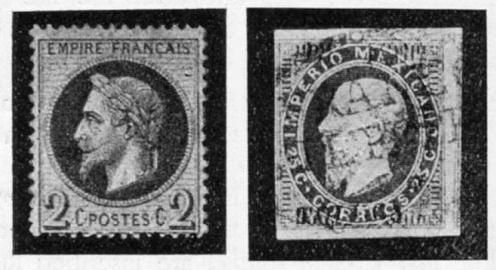 |
| Source |
Napoleon undertook a successful campaign in Central Europe, gaining victories in Austria, Italy, and elsewhere. To celebrate these, his head appeared on the stamps and coinage wreathed in victor's crown of laurel. The stamps were issued in 1863 and are known as the laureated type ; they were the work of Albert Barre, the engraver responsible for the Greek adhesives showing Hermes.
The Mexican expedition, largely owing to the Civil War troubles in the States, led to the placing of Emperor Maximilian on the throne of Mexico, and to the issue of stamps of the Mexican Empire bearing that ill-fated ruler's portrait.
The Franco-German War has left the stamp collector an interesting series of stamps catalogued as Alsace and Lorraine, but more properly called the stamps of the German Army of Occupation, as they were used in the parts of France occupied by the German Army during the war and afterwards in the two annexed provinces until superseded by the German Imperial issues.
In 1870-1, the Germans were surrounding the walls of Paris. The Government removed to Tours and then to Bordeaux, where at the latter place a printing press was set up under the direction of Monsieur Yon for providing the stamps required by the country.
Surrender of Napoleon III
September 2, 1870, witnessed the surrender of Napoleon to the Prussians at Sedan and the republic was restored. In November 1870 the Bordeaux issue - during the siege of Paris - therefore, gave the head of Ceres once more and the legend REPUB. FRANC, again appeared. Bordeaux supplied the stamps for the whole of the unoccupied area of France, with the exception of Paris which was isolated.
The capital sought out the old Ceres plates of 1849 and put them into commission once more, supplementing them by new plates for the low values of 1, 2, 4, and 5 centimes.
Thus France was using, at the same time, temporary plates engraved by Monsieur Yon at Bordeaux, new plates of small values engraved by Albert Barre, and old plates engraved many years earlier by J. L. Barre (father of Albert). The only difficulty in grouping these stamps is to distinguish between the Yon and J. L. Barre impressions. A scrutiny of the postmarks is of some assistance, but as a rule they are not very enlightening ; a better method is to examine the designs. The Yon specimens are comparatively crude, and the nose and forehead, with them, is very straight and the eye heavily shaded.
 |
| Source |
This period is undoubtedly the most interesting one in modern postal history. There is a vast array of Army postmarks of the war, special postcards issued by the auxiliary committee of the Red Cross at Strasburg, letters sent from Metz during the siege by free balloons, and letters sent by a variety of ingenious methods from Paris.
M. Steenackers was the Director of Posts under the republic proclaimed September 4, 1870, and his endeavours to maintain postal communications between Paris and the outer world are among the most fascinating of postal records. A cable was laid under the Seine to Rouen, but the Germans dragged the river and destroyed it. Telegraph wire had to be smuggled into the country, as the Swiss Government declared it to be contraband. Letters were enclosed in different forms of hollow spheres and thrown into the river; the spheres were flanged so that they would rotate with the current.
Hundreds of gallant messengers, ladies as well as men, strove to reach the city with concealed messages, mostly without success. One lady is said to have succeeded in getting through with a letter which had been secreted in a hollow tooth and the tooth stopped with gold. Even dogs were sent with messages to Paris, but most of them were shot by the enemy. The chief means of sending letters out of Paris was the balloon post, and almost the only messages received within the city came by carrier pigeons. There were free balloons and passenger balloons, a higher rate of postage being charged for the latter. Letter sheets, etc., were issued for both services inscribed "PAR BALLON NON-MONTE," or PAR BALLON MONTE. A register was kept of the services of aeronauts during the siege.
The messages sent by pigeons were at first written in very small handwriting, but afterwards they were photographed in microscopical minuteness, so that a very large number could be carried by one pigeon. These photomicrographs were projected on to a screen by means of an optical lantern to read and transcribe the messages when received in Paris. The films were placed in tubes attached to the pigeon's tail. One pigeon arriving in Paris January 28, 1871, delivered 40,400 messages by this means.
When hostilities ceased and commerce began again to assume normal conditions, the postage stamps were rearranged (1872). The Bordeax plates became obsolete, the low value plates were retained and new 10, 15, 30 and 80 centimes plates were provided by M. Hulot. These latter bore heavier and larger figures for the values than formerly. All, of course, showed the head of Ceres.
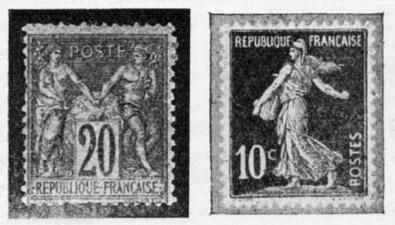 |
| Source |
The later and more peaceful history of France has been typified on its stamps by M. Jules Sage's allegory representing Peace clasping hands with Commerce across the world by means of the post, and by the late M. Roty's pleasing Semeuse or Sower design.
In 1876 France gave effect to its prosperity by using a design for the stamps which was allegorical of Peace and Commerce. Two full length figures were shown with the World placed between them and, in front, was a tablet reserved for the different values. Of this design, there are two types. In the earlier pattern, the tiny letters placed along the lowest edge of the stamp (to the left) show the V of INV. exactly under the space between the B and L of REPUBLIQUE, whilst, in the later pattern, the V figures below the U and B of the same word.
The "Peace and Commerce " stamps were retained until the end of the nineteenth century, but the colours were altered more than once, the paper underwent various changes, and the printers, at first, were the Bank of France, but later the work was undertaken by the Government.
A change of issue was felt necessary in 1899 and, in the year 1900, three new types were introduced. For the low values of 1, 2, 3, 4 and 5 centimes, an allegorical group including a female figure representing France in company with a cherub was used. It was a stirring little picture but had the appearance of a rough sketch rather than a finished drawing and can only be described as ineffective.
For the 10, 15, 20, 25 and 30 centimes values, a better design was executed. A female holding a scroll inscribed Droits de I'Homme formed the picture. Though skilfully executed, it caused a certain amount of friction, women asking why the weaker sex should not be mentioned in the legend. For the values of 40 centimes to 5 francs, a still better adhesive was prepared. This consisted of a long horizontal picture introducing a female worker.
The Droits de I'Homme stamps in their original form lasted but two years, a better rendering of the same pattern being produced in 1912. The easiest way to discriminate between the first and second type is to look at the tablet bearing the value. The first consists of a plain rectangle whilst the second is an ornate shield with curved sides.
Even this improved design did not give satisfaction and, as the current silver coins were considered so beautiful, it was decided to adapt the pattern of the coinage for the stamps. Accordingly the
" Sower " type of adhesives supplanted the Droits de I'Homme type in 1903. This design showed a graceful figure of a woman scattering seed in the furrows, with the rising sun in the background. The first value to appear of the new issue was the I5c. which was printed in a crude shade of sage green. The ugly colour killed the artistic line work and people turned against the set without further consideration.
So the quest for a really satisfactory picture proceeded. All were agreed that the shapely sower should be retained but that more fitting surroundings be provided for her. These suggestions were given effect in a second " Sower " type which was really the first rendering with the line background replaced by a solid mass of colour. This little engraving won a fair measure of praise and has been slightly modified from time to time to incorporate improvements as they have been conceived. To trace out the Droits de I'Homme and Sower types is a fascinating piece of work that may well be undertaken, especially if cuttings from the French press bearing on the controversy they have
caused are available for placing with the stamps.
Certain patterns of the 10 and I5c. denominations are found with the overprint, F.M. (Franchise Militaire). These are stamps given free to the military forces in accordance with a law instituted in 1900.
Special stamps were issued in 1914 to serve the double purpose of denoting postage and of collecting small contributions to the French Red Cross.
 |
| Source |
The Principality of Monaco has also issued a similarly overprinted stamp for the French Red Cross, and yet another of this class of stamp has been issued for the French Protectorate in Morocco.
FRENCH COLONIES
France began the issue of colonial stamps by providing one series common to all her overseas possessions. The same adhesive did duty in Nossi-Be or Guadaloupe, Mayotte or Martinique and the only clue to its place of origin was afforded by the postmark. The earliest issue consisted of six
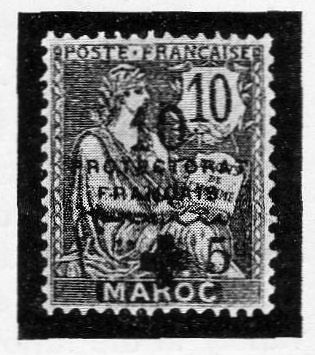 |
| Source |
When this set was withdrawn, the custom arose of using the current stamps of France printed on tinted papers and imperforated. As some of the home labels also appeared on paper that may be described as tinted and imperforated, a good deal of confusion amongst these items resulted in consequence. In some cases, the colonial specimens are easily discerned, but, in others, the only sure guide is afforded by the obliterations. When these are indistinct, no discrimination can be made.
In about 1881, a fresh set bearing the word "Colonies" appeared and these were used, as with the earliest issues, throughout the overseas possessions. One design consisting of a seated female figure served for all the values but each denomination was given in a distinct colour. Here again, the postmarks must be relied on to distinguish the particular colony of origin.
When the 1881 stamps had been in use a considerable while, there gradually sprang up the practice of applying an overprint to indicate the colony of issue. As a rule, this was done locally, often by means of primitive presses and with uneducated labour; consequently, there are many spelling mistakes in such overprints.
In 1892, a more comprehensive system was adopted. A new design revealing two figures seated beside a tablet was prepared and this was used for the various values. Below the value tablet appeared a second tablet which bore the name of the colony. Thus each possession was given, for the first time, its own stamps.
To marshal all the values and all the colonies of this series in our albums is a rather dreary business for the numerous items are identical save for the colours and the inscriptions in the name tablets. But there is a yet greater reason why such stamps should not be welcomed. They could be bought in an unused condition in Paris (at the Ministere de la Marine, we believe) at face value.
Probably this opportunity of purchasing the labels of remote colonies in the French capital proved a financial success, and, in order to draw still further on the resources of stamp-lovers, the authorities conceived the idea of issuing distinct designs for each dependency. A start was made with Obock and the Somali Coast in 1892-4 and some outrageous results were produced. More latterly the practice has been extended to all the colonies, and we now have an assortment of views, natives, animals, etc., to whet the philatelic appetite.
 |
| Source |
PLATE 18.
FRANCE AND HER COLONIES.
1. 1853, Napoleon III, Emperor.
2. 1862, Napoleon III, Emperor.
3. 1863, Napoleon with laurel wreath.
4. 1870, Ceres.
5. 1872, Ceres.
6. 7. 1876, Peace and Commerce.
8. 1900, i centime.
g. 1900, 50 centimes.
10, 11. The two types of the Droits de I'Homme issue.
12, 13. Two types of the Sower issue.
14. Stamp to serve for postal purposes as well as to collect money for the fund of Orphans of the War.
15. Colonial stamp overprinted with name of colony.
16. French stamp overprinted with name of colony.
17. Colonial issue of 1892.
18. 19, 20. Various picture issues of the colonies.
21. Dahomey, overprinted Togo, Occupation franco-anglaise.
Includes edited excerpts from The Project Gutenberg EBook of The Postage Stamp in War, by Fred. J. Melville and The stamp collector : a guide to the world's postage stamps (1920) by Stanley Johnson.
Includes excerpts from: Stamps of France: Detailed Notes on the First Issues (1872)
Free on-line albums for France and its colonies are available (in French) here.
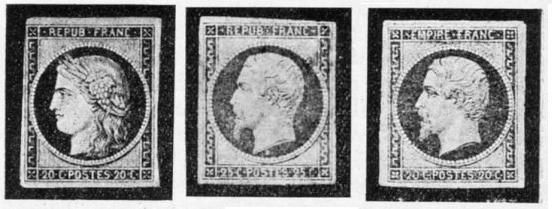
No comments:
Post a Comment